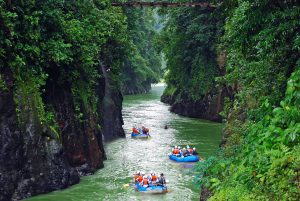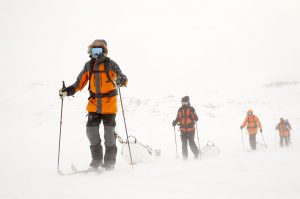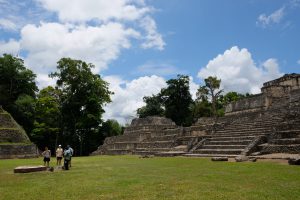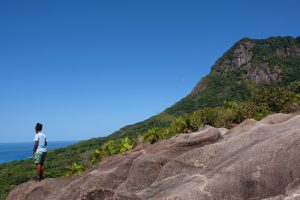
The citadel of Yaxchilan. Image: Alamy
Whether lost in a bat-infested underground labyrinth or caught up in an unexpected sacrificial ritual, you can feel the hand of the Maya on your shoulder in Chiapas, southeast Mexico. Words: Amelia Duggan
View online at natgeotraveller.co.uk
I’ve descended into the Mayan underworld, a sweating, calcifying maze built deep within the Lacandon Jungle, dark as obsidian and thick with tailless whip scorpions. “Keep moving!” Mildred Lucas hisses, her usual Mexican lilt replaced by a more urgent tenor. Up ahead, the feeble beam of my budget torch has stirred life into a canopy of bats. Their sinewy wings unfurl to reveal crumpled faces and parted jaws convulsing in rubbery squeaks. “Take this left… No, wait; go straight.” The air is putrid, the fauna terrifying, and it occurs to me, not for the first time, that my guide may be lost. I’m truly in hell.
“We know from carvings and deciphered glyphs that this labyrinth — one of the largest of its kind ever discovered — was built to symbolise the underworld. It was a place for Mayan royalty to commune with the gods.” Mildred’s voice reverberates along the stone passageway. “They would pierce their tongues, their flesh, their genitals, and burn the blood-splattered tissues, re-entering society with messages from the gods.”
Petite, polished and raised amid the urban chaos of Mexico City, Mildred Lucas may not be an archetypal tomb raider, but in the days we’ve spent together she’s introduced me to some of Mexico’s most preciously guarded treasures: the vine-strangled, ancient Mayan cities of its southernmost frontier state, Chiapas.
It feels like Mexico at its purest; there’s something so distinct and purposeful about the tapestry of this region it feels almost distilled. Its canyon-pitted, pine-crested highlands dissolve east to sultry jungle and south to fertile Pacific plains in bold strokes — its biodiversity outranks nearly every other state. The people are gregarious and warm hearted; their cuisine is hearty and spiced with centuries of tradition. Towns are pristine: paintbox-coloured, colonial and sleepy. And while travellers have cottoned on to these delights, Chiapas attracts but a fraction of the international attention its charms merit.
The maze tapers and spits us out at the edge of a bright jungle clearing. A gust dislodges yellow buds from some lofty epiphyte ecosystem, dusting a sunbeam. And towering over ground-level temples and lower terraces, and receding into the forest canopy, is a vertiginous, menacing acropolis — the centrepiece of Yaxchilan.
Sitting in a teardrop bend of the crocodile-rich Usumacinta River, this important Mayan city dominated the local region from around AD 580 until its collapse, along with large swathes of the Mayan civilisation, in the early ninth century. “From the glyphs, scholars think the original name of the city was Pa’ Chan. It means ‘cleft sky’,” Mildred says as we poke around the lower-level buildings, admiring the kings carved into the lintels. One of Mildred’s gifts is storytelling; as we explore, she repopulates the tumbledown ruins. A priest baring sharpened teeth skins a sacrificial victim on a cracked altar; armoured pok-a-tok players bash a flaming ball through the hoops of the stone court; a 19th-century explorer chisels out exquisite carvings, taking them away on a mule caravan for the British Museum…

A carving at Yaxchilan. Image: Getty
I’m in a reverie, strolling in my mind’s eye through a re-gilded temple, when I realise Mildred and I aren’t alone. I’ve somehow propelled a Mayan through the centuries. This man has long, wild, ebony hair and regal, high-set cheekbones, and is wearing an ankle-length white robe. But Mildred is greeting him like an old friend. “This is Elias. He’s an important leader of the Lacandon people and a guide.” He shakes my hand warmly. It’s then that I notice his entourage: five camera-wielding tourists.
“His people are the descendants of the Mayans; the Halach Winik — the true men,” Mildred translates, at his insistence. Chiapas has one of the largest indigenous populations in the country: a quarter of all inhabitants identify with one of 12 recognised groups. Fewer in number than the state’s largest indigenous groups — the Tzotzil and the Tzeltal — the Lacandones have, despite encroachments on their ancestral territory, somehow held on to their way of life, living in small communities in the jungle, some of which have started to embrace eco-tourism.
Leaving Elias to recount the history of his ancestors to his group, Mildred and I approach the acropolis, contemplating the steep ascent with eyes locked on the summit. The elaborate roof comb of a temple juts into the cloudless sky. “From the top, they pushed the losers of ball games, their bones breaking on the polished steps,” she says, grimacing. It’s a very, very, long way to fall.
The ruins of Yaxchilan aren’t as grand as the state’s most famous Mayan site, Palenque, nor their booty as sensational. But their remoteness commands a certain mystique. In 1952, while overseeing the restoration of Palenque, Mexican archaeologist Alberto Ruz Lhuiler heaved aside the lid of a stone sarcophagus to reveal the body of King Pakal, wearing a death mask of jade mosaic. In doing so, he sealed — or rather, unsealed — its reputation, inspiring generations of tourists. Meanwhile, Yaxchilan, sitting hard against the Guatemalan border, remained smothered in the impenetrable folds of the jungle, forgotten to all but a handful of archaeologists.
This all changed in the early 2000s. Today, a third of the site has been restored — a new wooden jetty welcomes travellers sailing in on lanchas hired downstream in the small town of Frontera Corozal; it can be visited in a day, along with the nearby ruins of Bonampak. Frontera Corozal is a three-hour drive from the cluster of hotels on the outskirts of the town of Palenque, a drive that had taken us past numerous grassy mounds that were suspiciously pyramid-shaped. “You’re not imagining it,” Mildred had told me. “They say that every 10km there’s a Mayan site waiting to be excavated. This is the heart of the Mayan world.” And to prove it, we’d pulled over at Camino Verde, a nondescript roadside guesthouse, whose restaurant’s trestle tables are heaped not with food but with ancient pottery and stone utensils.
I follow Mildred up Yaxchilan’s acropolis, praying not to twist an ankle. Nature is clawing at the structure, the once-uniform steps mossy and subsiding; the snarled roots of mottled ceiba trees having dislodged anything in their radius with the slow, crushing power of boa constrictors. We arrive, dishevelled, at the upper terrace. I stand where Yaxchilan’s rulers once stood, looking out over the jungle. I can see the greenish band of the Usumacinta; towering, vine-knotted trees bend under the fecundity of their own canopies. The jungle is singing, toucans chattering to each other over the rhythmic trill of cicadas. As I turn to examine the temple, a soul-rattling roar ricochets through the forest. Howler monkeys.
Sunlight filters onto an elaborately decorated structure, with sculpted figures and friezes depicting gladiators tumbling to their deaths. In the cooling gloom of its interior, where faint curlicues of terracotta and jade paintwork are still visible, sits a stocky, decapitated statue of eighth-century ruler Yaxun B’alam IV, aka Bird Jaguar IV — his crowned head resting in a separate niche. Soot streaks indicate the recent presence of candles: the remains of a shamanic Lacandon ceremony, venerating ancestral spirits. Modern Mayans, too, it seems, believe in a reality with many layers.

The cathedral of San Cristóbal de las Casas. Image: Alamy
The Bloms of San Cristóbal
“Life puts you in a place for a special reason; that’s what happened with Frans and Trudi,” José Gerádo Santiago says deferentially, ushering our tour group into a high-ceilinged room lined with cabinets of anthropological curios and hung liberally with aged, hand-drawn maps of the region. In the centre, a desk supports a typewriter and an open cigarette packet; on the back of a weighty, studded chair hangs a suede jacket with tasselled epaulettes. This is the study of Frans Blom, the trailblazing Danish archaeologist who made the highland colonial city of San Cristóbal de las Casas his home in 1950 and, along with his formidable Swiss photographer wife, Trudi, devoted his life to helping the Lacandon people.
“She was a jaguar,” José recalls, as we move into Trudi’s bedroom — a ruby-red boudoir decorated with photographs of long-haired Lacandon men and women. “She would rap people with her cane,” he chuckles. “But the Lacandones loved her. They called her shona; it means ‘lady queen’.” José knew Trudi at the end of her life; a whip-sharp, white-haired widow who could captivate audiences with tales of resisting — and eventually fleeing — European fascists, and whisky-fuelled revelries with an exiled Leon Trotsky and artists Frida Kahlo and Diego Rivera. Tales, too, of throwing together ambassadors and royalty with indigenous leaders and travelling hippies for dinner parties in the 1970s, when — due to the Blom’s work — their grand, antique hacienda, Na Bolom, began attracting visitors to San Cristóbal. The intrepid couple beat the path that many travellers now follow.
Na Bolom — a two-storey, multi-courtyard affair painted sunburst yellow and nurturing perfumed climbers — is more than a museum; it’s a living, breathing monument to the couple’s passion for indigenous rights and culture. But their battle is far from won: Mexico’s indigenous communities typically occupy the country’s least productive land, and are often subject to institutional prejudice and privations.
Run by the Bloms’ descendants, the estate hums with the atmosphere of a base camp. It’s home to devoted volunteers like Chiapan native José, who helps with tours and local initiatives; post-grad scholars huddled around the library’s fire; resident artists; paying guests; indigenous artisans; and those seeking specialist medical treatment, which Na Bolom funds.
While the journey from sweltering Palenque to the cool highland locale of San Cristóbal would’ve meant an arduous month’s donkey ride for the Bloms, my drive takes five hours, winding through mainly Tzeltal-populated communities — many of which (road signs proclaim) are run by the Zapatista National Liberation Army (EZLN). Led by the pipe-smoking Subcomandante Marcos, the political group grabbed world headlines on 1 January 1994 by staging a short-lived military coup across Chiapas. “It set off a bomb in the national consciousness,” José tells me. “All of Mexico was, for the first time, paying attention to Chiapas.” Since then, the Zapatistas have remained largely dormant, their sphere of influence limited to rural strongholds. There is talk, however, that they might put a candidate forward for next year’s general election.
My respects paid to the Bloms, I stroll back towards the centre of San Cristóbal, navigating a cobblestone grid of richly pigmented pastel villas. The city is blooming in the dying light; the baroque facade of its standout church, the Templo de Santo Domingo, glows peach above the cream-tented artisanal market, while inky birds urgently explore the trees of Plaza 31 de Marzo and a crisp half-moon hovers in the east. I pass a row of rustic-chic coffee shops, their raw material, harvested in the nearby Soconusco region, scenting the air with a heady perfume, before browsing in an amber jewellery emporium, strung with the petrified-fire of nearby mountain village Simojovel.
From either of its two church-crowned hills, the city appears serene — all quaint, red-tiled roofs, wonky steeples and glowing orange pinpricks of light. But down amid the thronging bars and restaurants of Calle Guadalupe, it’s another story; come nightfall, postcard-perfect San Cristóbal unstays her corset and throws caution to the mountain winds. The competing riffs of mellifluous jazz and rabble-rousing cumbia are a siren-call to thirsty tourists, and it’s not long before I’m in the ambiently lit courtyard of TierrAdentro, tapping my foot and nursing a tumbler of mezcal.
Part diner, part late-night music venue and part bazaar, TierrAdentro is run by Zapatista supporters. To one side, a cosy bookshop sells left-wing texts and Mayan history books, while, next door, indigenous women wearing embroidered huipil blouses and full skirts run a colourful stall celebrating the Chiapan village craft of weaving. But TierrAdentro’s real USP is its espousal of all things — and all people — revolutionary: posters, fliers and even the placemats quote Marcos and subversive 20th-century writers, while Che Guevara and the Virgin Mary, shouldering bullet-straps like Mexican revolutionary Pancho Villa, look down from the walls.

Cathedral San Juan Bautista. Image: Alamy
Early the next morning — my last in Chiapas — I travel six miles north from San Cristóbal to the mountain township of San Juan Chamula, home to a fiercely proud community of Tzotzil Maya. The weather has turned biblical. With no protection against the lancing torrents, the locals — clad in their traditional fluffy wool skirts and chuje tunics — abandon their vegetable stalls, zigzagging through the main plaza for cover at the local courthouse. I’m all for running, too, but my guide, Hector Mojia, is made of sterner stuff.
We duck into Cathedral San Juan Bautista — from the outside, a rustic, whitewashed church — and find ourselves standing on a loose carpet of pine needles before a sea of lit candles. Hundreds of tapers flicker on the floor of the nave and along the walls, casting an ethereal glow on dozens of Catholic effigies in glass cases.
Hector takes me over to get a closer look at one of these statues, navigating around a group of locals who appear to be picnicking on the church floor. As I look at the effigy, I’m struck first by the flowers — an improbably exotic arrangement of fresh white lilies and fat, yellow daisies — and then by its odd attire. Saint Jude Thaddaeus, his glossy white face tilted heavenwards, is swaddled in multiple ponchos and festooned with chunky hawthorn-fruit necklaces. A vanity mirror pinned to his chest reflects my bemused expression back at me.
“The first thing the Spanish did when they conquered the area was to kill the spiritual leaders. But the old Tzotzil religion lived on, and each of the saints came to symbolise a different god,” Hector whispers to me. I look again at the group of locals. What had at first appeared to be a picnic is actually a shaman-led ritual; a docile black chicken is being cradled by a plump woman; various herbs, bones and, confusingly, a litre of Coca-Cola, are laid out beside her. As she chants and rocks, it occurs to me the chicken’s minutes are numbered.
Hector continues quietly: “John the Baptist is revered above Jesus here. Because his feast day falls around the summer solstice, he became an embodiment of their sun god.” What started as a way to conceal their polytheism from Dominican priests became, as the population converted, something more complex, he says: a nuanced braiding of indigenous and Catholic beliefs.
For someone familiar with traditional Christian iconography, experiencing Chamula’s cathedral is like stepping through the looking glass. And yet it’s also organic. The region’s landscape and biodiversity have a starring role in the decoration — in the leaf-strewn floor, the jaguar painted on the ceiling, the arcs of jade cloth standing in for the highlands’ peaks. It seems, too, that the countless candles echo the star-flecked heavens on a cloudless, highland night.
I ask about the mirror fixed to the chest of our saint. “They’re powerful things, for the Tzotziles. They’re able to deflect away bad spells,” Hector says, as, nearby, a muffled cluck signals the end of the chicken. Like their descendants here in Chamula, the ancient Mayans believed mirrors to be potent spiritual tools, he tells me. They could open portals into the ‘other world’, through which ancestors and gods could communicate. I think back to that headless statue of Bird Jaguar IV I’d seen in the temple of Yaxchilan, and imagine him summoning visions from a slab of highly polished stone — as blood loss and cloying incense conspire to rob him of his faculties.
And once more, I’m struck by the sense that here, in Chiapas, Mayan culture isn’t just for archaeologists. Nor is it something defunct, discovered only in history books. It exists — albeit filtered by time and outside influence — in the cosmologies and customs of indigenous Mexico. These ways of life are under threat: long-held practices are slowly being abandoned. But, for now at least, in Chiapas, the echoes of this history resound. Here, Mayans can be seen and heard. No portals required.

Market, San Juan Chamula. Image: Alamy
Essentials:
Getting there & around
British Airways and Aeroméxico fly to Mexico City, while British Airways, Virgin Atlantic, Thomson Airways and Thomas Cook Airlines fly nonstop to Cancun. From there, take a domestic flight on to Chiapas’ state capital, Tuxtla Gutiérrez. The city’s small Ángel Albino Corzo International Airport is 21 miles south east of San Cristóbal de las Casas.
Average flight time: 15h 30m with connection.
There are few car rental opportunities in Chiapas, although Tuxtla has a number of agencies in town, including Alamo and Europcar, as well as at the airport, while San Cristóbal has Optima (T: 00 52 967 674 54 09).
Fortunately, bus links within the region and to other states are very good. For regional routes, OCC minibuses, combis and colectivo taxis are a good option. Roads between tourist attractions are well maintained, although often subject to small protests and roadblocks; it’s a good idea to factor in some extra journey time.
When to go
Blue skies are most common in the dry season (November to April), although evenings can be chilly in San Cristóbal and the surrounding highlands between November and February. The lowlands and coastal regions, however, are warm year-round. June and September see heavy rains, with moderate showers occurring in the months between.
Where to sleep
Chan-Kah Resort Village (Palenque)
Hotel Mexicanos (San Cristóbal de las Casas)
More info
visitmexico.com
The Maya by Michael D Coe and Stephen Houston (Thames & Hudson). RRP: £16.50.
Incidents of Travel in Yucatan, Vols I and II by John Lloyd Stephens and Frederick Catherwood (Cosimo Classics). RRP: £16.99.
Lonely Planet Mexico. RRP: £14.99.
How to do it
Cox & Kings has a 14-day escorted tour of Mexico from £2,795 per person, including British Airways flights, transfers, excursions and accommodation with breakfasts and some other meals.
For more information on visiting Latin America, consult the Latin American Travel Association.
Published in the May 2017 issue of National Geographic Traveller (UK)











